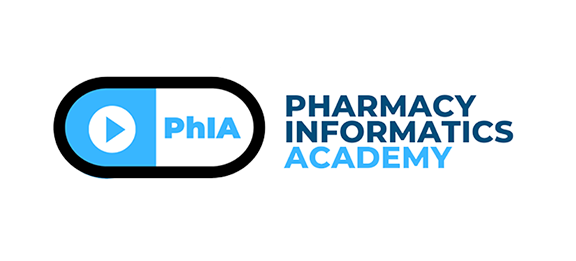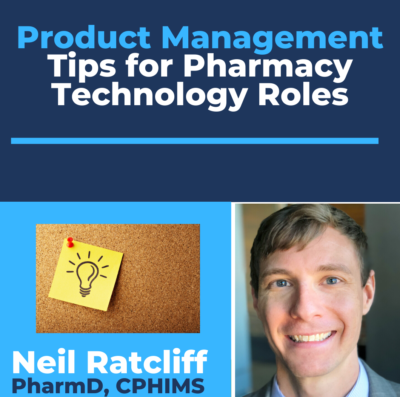Product Management Tips for Pharmacy Technology Roles
While studying for personal development and to become more effective in my position at a pharmacy technology company, I’m constantly reminded that being in pharmacy technology roles involves many of the same responsibilities and soft skills in product management. I thought I’d share my notes on some of the areas where a product manager and informatics/technology pharmacist overlap, as well as offer some tips to get those new to pharmacy informatics and technology off to a productive start. It doesn’t mean they are interchangeable roles, so take what applies to you or your aspirations, and grow your value to your team. And, I encourage you to remember you are in the profession of Pharmacy first.

A brief disclaimer, especially to appease those in true product manager roles: I’m using “product manager” in the context of any connective role that is product adjacent. Other titles where these tips came from are product owner, project manager, program manager, and business analyst. This also pertains to my personal experience, so I know this may not apply to every situation and organization. I welcome any feedback and distinctions warranted.


Skills of the Product Manager
Required skills of product managers, as outlined in Product Management in Practice, are easy to remember with the acronym “CORE”:
- Communication – “clarity over comfort” – This is the most important skill for a product manager, and probably most of us. You must be willing to work through discomfort in order to make sure all stakeholders are aligned. Consequences may be small or life threatening, especially in the healthcare setting.
- Organization – “change the rules, don’t break the rules” – Organize the team for successful collaboration, so if a process or practice is broken, change it. Allowing exceptions and “one-offs” can lead to significant technical debt and overhead in the long run.
- Research – “live in your user’s reality” – Research new ideas and perspectives from all of your users. While we may be subject matter experts in pharmacy, learn about nursing workflow or what your providers may be interested in.
- Execution – “no work beneath, no work above” – Execute whatever day-to-day tasks are required for the specific role and team. This will mean stepping up to do something that isn’t part of your job description. This doesn’t mean you have to do everything yourself.

I also recommend the LinkedIn Learning course on Becoming a Product Manager by Cole Mercer, which guided the next sections. Regarding getting to real user needs, the following has been very helpful in my own role: We often hear requests, but it isn’t really what the person needs. Being a product manager is about finding solutions to problems, not fitting problems to a solution that we have already thought of. We need to be aware of unintended side effects. Just like with medications, modifying our EHRs, systems, and devices can develop consequences that may be unexpected and harmful to the system and our patients. Ask what is behind the request. Ask “Why?” then ask is it two more times. This is a sales technique that helps get to the root of a problem that a person wants solved.

How can you get started?
It is usually a long ramp up period for these roles, so here are some tips for the first few weeks as a product manager or informatics pharmacist:
- Talk to your manager about their expectations for you and any advice they have on getting ramped up. Then, find out what the highest priority problem is on the team at the moment and focus research there.
- After getting acquainted with the team, schedule a short meeting with every major stakeholder or team leader that you’ll be working with, like folks from engineering, marketing, legal, sales, etc. For pharmacy informatics, that may be pharmacy leadership, nursing management, physicians or providers, IT, the medical billing/coding department, etc. Use the time to introduce yourself and ask them what their biggest challenges are at the moment. This may take weeks, but is worth the time and effort.
- If there is an internal wiki or knowledge base, read as much documentation as you can. Do as much product immersion as possible. Focus particularly on any documents made by someone who was in your role previously or direct peers.
- “Get out of the building”. Talk one on one with as many users of the product or system as you can. Volunteering to help the customer support team a few hours a day for a couple of weeks. You may already be part of the Help Desk team and expected to handle tickets, but dig in deeper. You’ll build rapport with your colleagues there and you’ll learn more from talking directly with users directly than from a survey.
 Of course, doing all of these things takes some time, so don’t be afraid to space it out a little bit over several weeks. Once you’ve used these tips to get familiar with the team, the processes, products, and the biggest user problems, you’ll be way more comfortable and well underway to making a huge impact as a product manager or pharmacy technology team member.
Of course, doing all of these things takes some time, so don’t be afraid to space it out a little bit over several weeks. Once you’ve used these tips to get familiar with the team, the processes, products, and the biggest user problems, you’ll be way more comfortable and well underway to making a huge impact as a product manager or pharmacy technology team member.
I hope some of you find this helpful and I really look forward to others weighing in and sharing your product management resources!
If you liked this post, check out Pharmacy Informatics Academy blogs here

